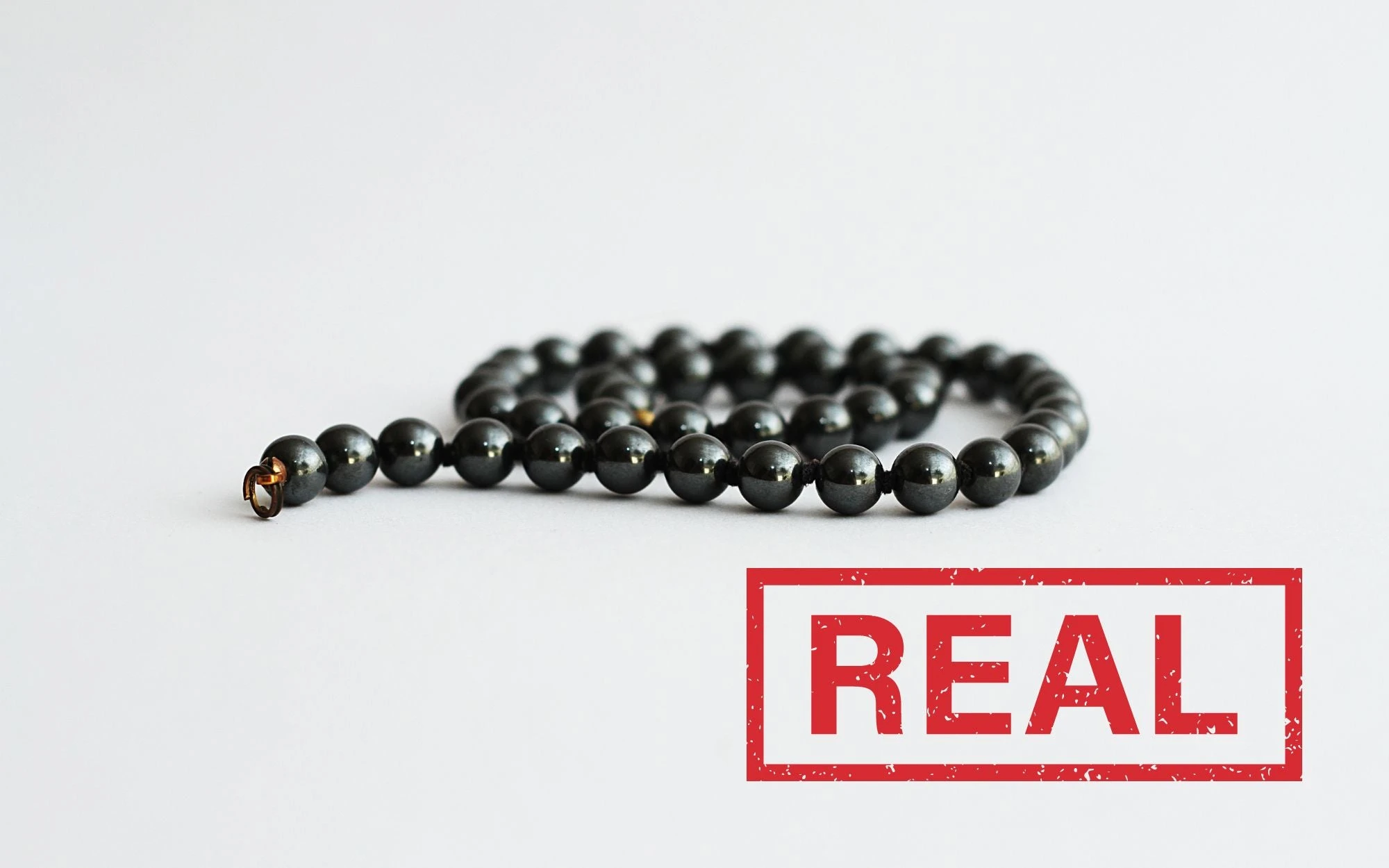If you wish to harness all the hematite bracelet benefits, you should only get the real deal.
Hematite bracelets are all the rage in the world of jewelry, but not all that glitters is genuine. With an abundance of fake pieces flooding the market, it’s crucial to know how to distinguish between real and counterfeit hematite bracelets.
That’s why we’re here to teach you how to tell a real hematite bracelet from a fake one.
By understanding the distinctive characteristics of authentic hematite, you can make informed purchasing decisions and avoid being misled by imitations. Get ready to uncover the secrets behind spotting genuine hematite and ensuring your jewelry collection shines with authenticity.
In this article
How to Tell a Real Hematite Bracelet From a Fake One

To tell a real hematite jewelry from counterfeits, consider the factors below:
Metallic Luster
Natural hematite: Has a distinct metallic luster that sets it apart from imitations. When you examine a hematite bracelet, look for that shiny, reflective quality that resembles metal.
Imitation hematite: May have a less natural sheen, looking more like painted plastic or glass.
Natural Imperfections
Natural hematite: Often exhibits natural imperfections like small cracks or irregularities. These imperfections are quite common in real hematite and can be seen as evidence of its authenticity.
Imitation hematite: If the hematite beads in your bracelet are flawless, it could be a sign that it is not real.
Smooth and Cool Touch
Natural hematite: When held against the skin, genuine hematite typically feels smooth and cool to the touch. This unique sensation is a result of its composition and can help you differentiate it from fake alternatives.
Imitation hematite: May feel lighter and warmer, similar to plastic or resin.
Color Variation
Natural hematite: Typically metallic gray to black in color. However, keep in mind that some natural variations may occur due to different mineral compositions or impurities present in the stone.
Imitation hematite: May be overly bright or has a uniform color throughout. This is because it is often painted to mimic a natural stone.
Weight and Density
Natural hematite: Tends to be heavier than its imitations, giving it a sense of density and substance for its size. When comparing bracelets, pay attention to their weight as an indicator of authenticity.
Imitation hematite: Often lighter and will feel less substantial especially if made of platic.
Magnetic Properties
Natural hematite: is weakly magnetic or non-magnetic. If you have a strong magnet on hand, try holding it close to the bracelet. If there is no magnetic attraction or only a minimal one, then it’s likely the bracelet is made of genuine hematite.
Imitation hematite: Often strongly magnetic, which is a giveaway.
By keeping these tips in mind when examining hematite bracelets or gemstones, you’ll have a better chance of identifying genuine pieces from fakes.
Now that you know the key differences of genuine and counterfeit, it’s time to do some tests. In the following sections, let’s explore some methods to determine the genuineness of the hematite you’re looking to buy.
Method 1: Magnet Test
Real hematite bracelets often possess weak or no magnetic properties due to their iron content. This means that they can be minimally attracted or repelled by a magnet. On the other hand, fake hematite bracelets can be made magnets and strongly magnetic.
To determine if your bracelet is made of genuine hematite, you can perform a simple test using a magnet. Take a magnet and bring it close to the bracelet. If the bracelet has a feeble response to the magnet, there’s a good chance it’s natural stone. However, if it reacts strongly to it, that could be a sign that’s it’s unreal.
While using a magnet can provide an initial indication of authenticity, it’s to perform additional tests to confirm it. Consider other factors such as the ones below.
Method 2: Red Streak Test
Hematite leaves behind a reddish streak when rub against unglazed porcelain.
Take your hematite bracelet and rub it against the surface of an unglazed porcelain tile. Apply some pressure as you move the bracelet back and forth.
If the bracelet leaves behind a reddish streak on the tile, there’s a good chance that it’s made of authentic hematite. The red color comes from iron oxide, which is present in genuine hematite gemstones.
It’s important to note that this test may not be suitable for all types of fake bracelets. Some imitations are made using materials that can also leave behind a red streak, making it difficult to differentiate between real and fake.
While the red streak test can provide some indication of authenticity, it’s not foolproof. To make a more informed judgment, let’s continue testing other factors using the next method.
Method 3: Reflection Check
To further determine if a hematite bracelet is real or fake, you can use the reflection test. Hold the bracelet under bright light and observe its reflection. Genuine hematite should have a mirror-like shine, indicating its authenticity.
Imitations, on the other hand, may appear dull or lackluster when compared side by side with genuine pieces. The difference in shine is usually quite noticeable, making it easier to identify fakes. So, if the bracelet lacks that eye-catching gleam, it’s likely counterfeit.
Pay close attention to any rainbow-colored reflections on the surface of the bracelet. These could indicate fake coatings applied to mimic the appearance of real hematite. Authentic hematite does not exhibit such colorful reflections.
By conducting the reflection test, you can quickly distinguish between a real hematite bracelet and a fake one. The genuine piece will reflect light beautifully with a mirror-like shine, while imitations may appear dull or have rainbow-colored reflections due to artificial coatings.
Remember that this method alone may not be foolproof, as some sophisticated imitations can closely resemble real hematite. However, when combined with other tests and observations like the red streak test mentioned earlier, you can increase your confidence in determining whether a hematite bracelet is genuine or not.
Method 4: Surface Inspection
Aside from its reflection, it’s also crucial to closely examine the stone’s surface. By doing so, you can spot any telltale signs that may indicate its authenticity. Here are some key points to consider during the surface inspection:
- Signs of peeling or flaking paint. Genuine hematite bracelets typically maintain their natural appearance without any added layers or coatings. So, if you notice any inconsistencies in the paint job, it’s likely a fake.
- Scratches on the surface. Another clue that can help you differentiate between real and fake hematite bracelets is the presence of scratches on the surface. Genuine hematite is a relatively durable stone, so it should not easily scratch. If you observe numerous scratches, it suggests that the bracelet may not be made of real hematite.
- Color variation and luster. Real hematite bracelets often exhibit subtle variations in color and luster due to their natural formation process. In contrast, fake bracelets may have an overly bright or uniform color throughout. This lack of variation can be an indication that the bracelet is not genuine.
By thoroughly inspecting the surface for signs of peeling or flaking paint, scratches, and color variation, you can gain valuable insights into whether a hematite bracelet is real or fake. Remember to trust your instincts and use these visual cues as helpful guidelines when making your assessment.
Method 5: Cold Touch Test
Real hematite tends to feel cold when touched, even in warmer environments. So, if you hold the bracelet in your hand and it feels chilly, chances are it’s the real deal.
Imitations, on the other hand, often adopt the ambient temperature and may feel warm to the touch. This occurs because fake hematite bracelets are usually made from materials that conduct heat differently than genuine hematite. So, if you pick up a bracelet and it feels warm or room temperature, it’s likely a counterfeit.
It’s important to note that this method should be used in conjunction with other methods for a more accurate assessment. While the cold touch test can provide initial insights into the genuineness of a hematite bracelet, it is not foolproof. Check the other factors mentioned above to increase your chances of finding real hematite jewelry.
Wrapping Up
Congratulations! You are now well-equipped with the knowledge to distinguish between a genuine hematite bracelet and a fake one. By following the tips and tests outlined in this blog post, you can confidently make informed decisions when purchasing hematite jewelry.
Now that you possess these skills, go forth and shop for your perfect hematite bracelet with confidence. Embrace your inner gemologist and enjoy the journey of discovering beautiful, authentic pieces that resonate with your style and energy.
FAQs
Can I use these tests on other types of gemstone jewelry?
The tests mentioned in this blog post are specific to identifying real hematite bracelets. While some tests like magnetism may apply to other gemstones, it’s essential to research specific identification methods for each stone as properties can vary.
Can I perform these tests without damaging my bracelet?
Aside from the red streak method, the tests described here should not cause any significant damage to your bracelet if performed correctly. However, it’s always advisable to exercise caution and conduct them on inconspicuous areas whenever possible.
What if my bracelet fails one or more of these tests?
If your hematite bracelet fails one or more of these identification tests, it is likely not made from genuine hematite. Consider reaching out to the seller for clarification or seek reputable sources when purchasing gemstone jewelry.
Where can I find genuine hematite bracelets?
You can find genuine hematite bracelets at reputable jewelry stores, gemstone specialists, or online marketplaces that have a track record of selling authentic products. Be sure to read customer reviews before making a purchase.
Ready to own a hematite bracelet? Browse our collection of hematite jewelry here.
